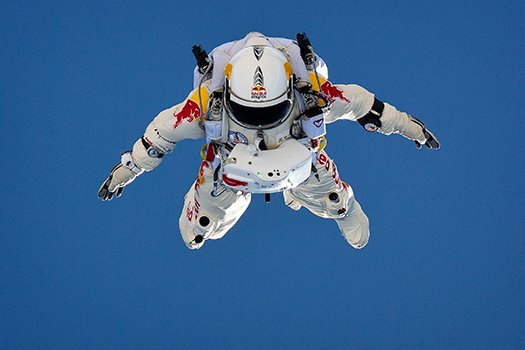Baumgartner’s fall defies scientific expectation
On Oct 14, Felix Baumgartner literally brought human capability to new heights, engaging in a free fall from 128,100 feet above the earth’s surface in a project entitled “Stratos,” sponsored by Redbull. The world watched from video cameras attached to his helium balloon and pressure suit as Baumgartner successfully broke the sound barrier and landed safely in the New Mexican desert.
Though the world was astounded by this daredevil’s record breaking descent, the technological preparations taken to achieve this goal are what’s really spectacular. Arrangements had to be made to prevent both controllable and uncontrollable risks present during the jump.
According to Irene Guerinot, instructor and lab coordinator of MC’s science department, these risks included pressure loss inside the suit, oxygen deprivation and freezing temperatures, along with concerns about weather. Baumgartner’s team clearly assessed these risks and worked towards the final jump date for five years.
According to Redbull’s Project Stratos website, Baumgartner’s team was made up of “world-leading experts in medicine, science and engineering, including a former NASA crew surgeon, record-breaking aviators, and designers of some of the most innovative aircraft ever produced.” The “aircraft” referred to above consisted of plastic film that was only 0.0008 inches thick, as reported by the Stratos website.
The balloon encompassed 30 million cubic feet and stretched 55 stories high when expanded, and was capable of carrying Baumgartner 24 miles above earth while filled with helium. The balloon, while certainly impressive, does not even compare to the pressurized suit and helmet custom designed to protect Baumgartner from any hazards. According to Guerinot, the type of technologies developed specifically for the Stratos dive are significant because they can be used for future endeavors performed by NASA or private companies.
However, viewers watching the big drop on that exciting Sunday may have been asking themselves an important question: “Why is there a big Redbull logo on that cool space suit?”
“An attempt like [Baumgartner’s jump] would not have passed through government bureaucracy,” Guerinot said. “Private companies do not face the limitations that government organizations face.”
Redbull did not work alone in this endeavor, however. A team of NASA professionals observed and assisted in the entire preparation and diving process. The specifically designed suit, fire retardant on the outside and insulated against extreme cold on the inside, was Baumgartner’s only protection while descending back to the earth’s surface. The suit was pressurized to 3.5 pounds per square inch of the diver’s body, and made to eliminate the possibility of experiencing “the bends,” or decompression sickness due to pressure change within the body.

Felix Baumgartner broke the sound barrier while jumping 120,000 feet from space.
The suit contained a “brain” the size of a hockey puck that controlled the internal pressure and temperature of the suit and made the ride down inside of it much easier to bear for Baumgartner. The helmet used along with the suit contained an oxygen provider, which made sure that the diver was breathing healthily throughout the entire descent.
It also contained a heating unit which prevented fogging or icing and made Baumgartner’s view virtually unblemished by distortions. The suit and helmet were custom designs based off of the David Clark Company’s standard pressurized suit used routinely by Air Force and NASA pilots.
So, while the world watched with expressions of shock, terror, excitement or just plain curiosity on their faces as a human being fell 833.9 miles per hour for over nine minutes, they saw not only the impressive feat of a daredevil, but also the exciting innovations of technology that broke both the sound barrier and the expectations of the scientific world.
